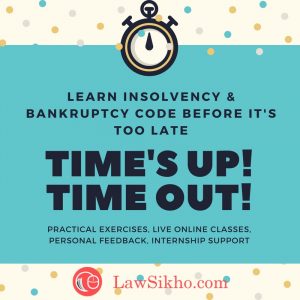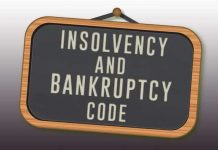This summary is written by Nandini Biswas, a student from NMIMS School of Law, Bengaluru.
Introduction of the host- Siddhant Baid
Mr. Siddhant Baid is currently the CFO of LawSikho.
He pursed Engineering degree in Instrumentation and Control from Kurukshetra University. He further did his MBA in International business from Symbiosis Institute of International Business.
Before joining LawSikho, he worked in many banks. He was the Manager of Emerging Corporates Group at HDFC bank, Senior Manager of Commercial Banking with Yes Bank, Vice President at HSBC Commercial Banking, and Vice President at Angel Works.
Introduction of the guest- Piyush Jain
Mr. Piyush Jain has a vast experience in dealing with IBC and banking laws. The company where he works in currently has dealt with IBC laws in sectors like real-estate, manufacturing, services, etc. He has been involved in drafting resolution plans for acquisition of assets under IBC.

Summary of the Webinar- Commercial aspects of resolution plans under IBC for lawyers
- Why was IBC conceived?
There were two main reasons for the introduction for Insolvency and Bankruptcy Code (IBC), 2016:
- Low rate of recovery to recover dues from borrowers. The recovery rate was as low as 3% through consumer courts and 14% through SARFAESI Act. The recovery had to be increased.
- To create a mechanism where companies could be bought over by a litigation free method.
Average recovery rate of IBC has been 42% to 45% in the last years since its introduction.
- What has been your experience while dealing with IBC?
There were many limitations and loopholes in IBC when it was introduced, but the government was pro-active to bring about regulatory amendments like Section 29A, revised the timeline to deal with IBC cases, etc. The act has been amended from time to time to make it more efficient.
- Who are the stakeholders in IBC?
- There are two classes who can claim the money from the company:
- Financial creditors- who gave the money to finance the company.
- Operational creditors- All the suppliers who have provided services.
- The stakeholders are:
- Financial creditors.
- Operational creditors.
- Promoters who have lost their money.
- Government agencies who had invested.
- Lessors.
- Do NCLT litigation lawyers do the work of contract drafting or by the IRP?
Once a company is insolvent, the Board of Directors is replaced by the Financial creditors committee. The legal contract drafting will be done by lawyers. IRP is only supposed to run the affairs of the company as per the insolvency guidelines.
- Why will there be litigation once a resolution applicant puts forward a plan?
Most of the litigation happens around the liquidation value assigned by the committee of creditors. Litigations happen since, all the stakeholders do not get paid. Financial creditors are the first one to get the money and once their debt is settled, other stakeholders are paid and then the shareholders are paid. All of this payment is made through selling off the assets of the company. If the liquidation value of the of the assets are less, all the stakeholders to not get their money back. Thus, deciding the liquidation value of such assets are crucial.
- What are the extinguishment of personal guarantee in virtue of the clause entered in the resolution plan?
The resolution plans are only extinguishing the right of recovery of promoters. This means, if banks are able take money from the promoters through personal guarantees, the promoters cannot claim the money from the debtor company. The clauses in IBC compromise on the interests of personal guarantors. The promoters are largely left to fend for themselves on the personal guarantee aspect.
- How does the IBC protect the stakes of unsecured creditors?
All the decision-making powers rest with the committee of creditors. Majority of the money goes to the secured creditors. The interests of the unsecured creditors are compromised. The only way the unsecured creditors can secure their interests is by dealing more with the liquidation value and the way the liquidation value is assigned to the business, since there is huge gap observed between the value of the assets assigned as compared to the market value. It has been observed that, only individual values of land machinery etc. is accounted for. The value addition process and the scope of revenue is ignored. Therefore, they need to start challenging the ways of the assigning liquidation value.
- Who has the fundamental duty to review the resolution plan and check if they comply with the law being in force?
It is the duty of the Resolution professional to review the resolution plan and check if they comply with the law being in force. They are supposed to give a certificate if the resolution plan is approved by the COC.
- What is the role of the lawyer after the admission of a matter?
Anybody who has a stake in the process needs lawyer to protect their interest at the NCLT court if they are not happy with the resolution plan. Thus, a lawyer needs to represent such people at the court.
- After admission of the principal body to CIRP, can creditor proceed against the personal guarantor under Section 95 of IBC?
The banks can go to NCLT to initiate proceedings against company who have become bankrupt under the personal guarantee and this can happen simultaneously with the insolvency proceedings against the corporate debtor.
- The aim of the IBC is asset maximization then why cannot the NCLT send back the plan which does not maximize the asset?
Since the financial creditors, that is the banks, lend money to the companies after analyzing their balance sheets and the value of their assets, they are best placed to assign the liquidation value of the asset of the company once it has become insolvent. Courts as legal forums, they do not intervene in commercial aspects.
- How to ensure that the promoters to not influence the whole process of deciding the liquidation value?
Since the promoters cannot put up a resolution plan, they cannot influence the process.
- Can the NCLT modify the resolution plan?
There has been an instance where the NCLT had asked to relevant authorities to modify the plan since the plan did not take care of the livelihood of the employees. If the plan does not have any commercial wisdom which is glaring, and the court comes to know about it through the counsels, the court can order the Resolution applicant to modify the plan or reject the plan.
- Can the personal property of promoters be liquidated when the promoter mortgages the property to secured creditors under the IRP?
IBC is about corporate insolvency. With modification of the IBC laws in December 2019, if the bank files a case of personal insolvency with the NCLT against a promoter of the defaulting company, all their assets, whether mortgaged or not mortgaged will be dealt through the IBC laws.
- What happens if the implementation of a resolution plan fails, will it go in liquidation or is there any other process?
The act stipulates mandatory liquidation, but this part is tricky since, not all businesses can be liquidated, like in real estate sector. If a real estate company is bankrupt and it has an under-construction project that can be viewed as an asset, such a project cannot be liquidated. This is something, that the government needs to work on.
- What steps should be taken by RP to resolve an insolvent company and arrive at good resolution plan apart from complying with the provisions of the court?
RP should generally engage firms like PWC and some investment banking firms, who can market the assets to more and more investors.
LawSikho has created a telegram group for exchanging legal knowledge, referrals and various opportunities. You can click on this link and join:












